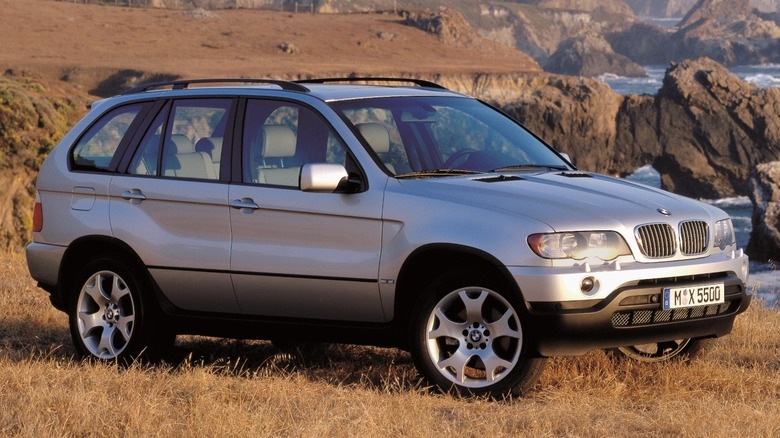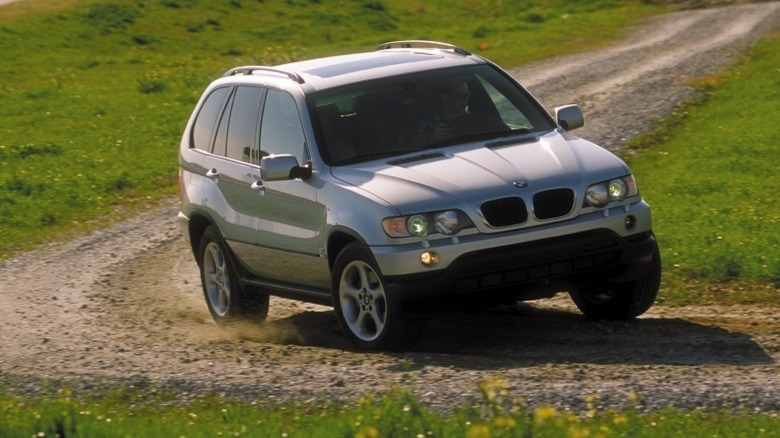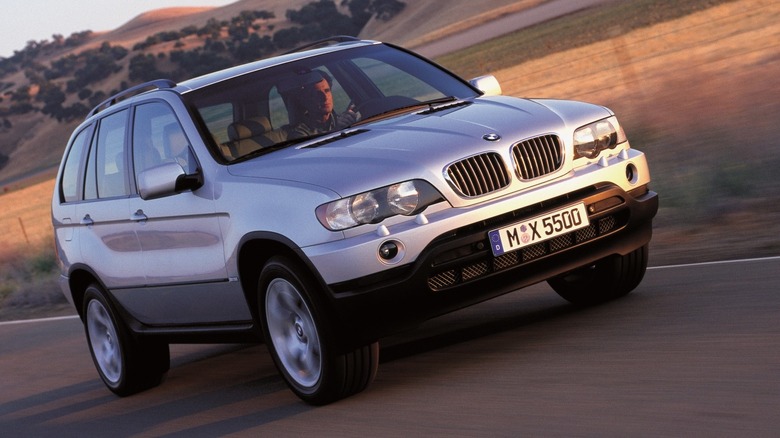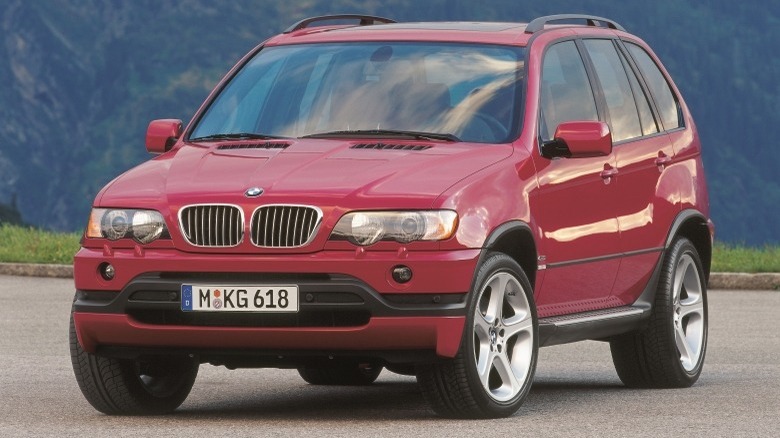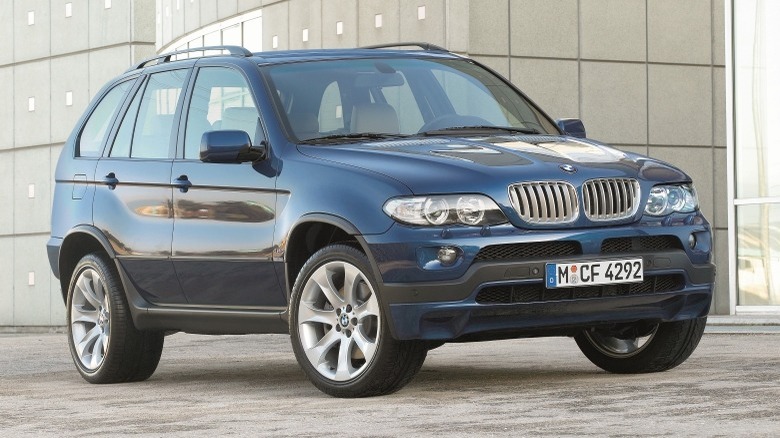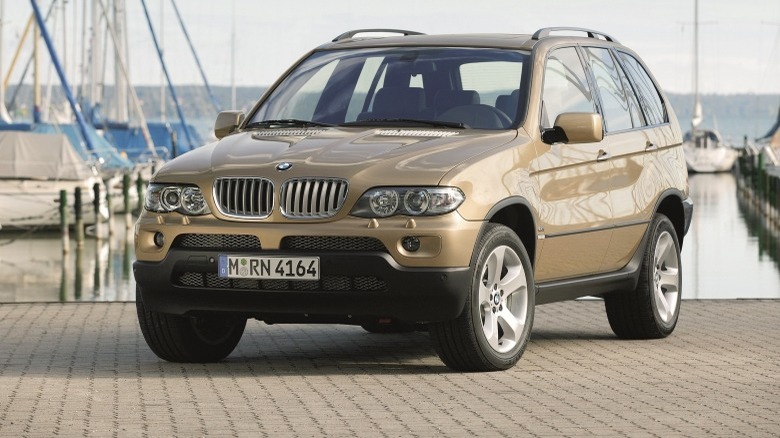All About The Engines In The BMW X5 E53: Horsepower, Torque, & Other Specs
After the midsize SUV craze took off in the '90s with the introduction of the Ford Explorer, Jeep Grand Cherokee, Toyota RAV4, Honda CR-V, and Mercedes-Benz ML (now GLE), BMW in 1999 hopped on the train by adding the BMW X5 E53 to its portfolio, which was previously dominated by luxury sedans and rear-wheel drive sports cars. As a result, the E53 became both the first X5 generation and BMW's first SUV (in case you're curious, E53 is the factory code for the first BMW X5 generation). BMW's goal at the time was to create a high-riding vehicle with the versatility of an SUV and driving dynamics typical of its performance cars. And so the X5 E53 was based on the BMW E39 5 Series but also shared features such as a split tailgate and hill-descent control with the Range Rover.
By the time it was ready for the market, the midsize luxury crossover SUV was complete with a sturdy unibody construction that made it relatively lightweight compared to SUVs with body-on-frame design, an all-wheel drive layout, a stiff, fully independent suspension system with dynamic stability control, and later a range of brawny engines laying beneath its beautiful skin. The BMW X5 E53 initially offered a 4.4-liter M62 V8 at launch for the 2000 model year, and then a 3.0-liter M54 straight-six the following year. Eventually, by 2006, the engine count had grown to five for the gas-powered first-generation X5, following the introduction of the 4.6-liter M62 V8 in the X5 4.6is, 4.4-liter N62 V8 in the revised X5 4.4i, and a larger 4.8-liter N62 V8 in the 4.8is. The Bavarian giant also offered the celebrated BMW M57 straight-six diesel engine under the hood of the E53 X5 3.0d for those wanting an oil burner. Here's a look at the engines that were in the BMW X5 E53 and their specs.
BMW X5 E53 3.0-liter M54 engine specs
The 3.0-liter M54B30 straight-six was the smallest gasoline engine offered on the crossover SUV. It powered the BMW X5 3.0i between the 2001 and 2006 model years, generating 225 hp and 214 lb-ft of torque. That output makes its way to the wheels via either a 5-speed manual transmission (a six-speed manual was offered from 2004) or a 5-speed automatic. Equipped with the manual, the 2002 BMW X5 E53 3.0i shoots to 60 mph in 8.1 seconds; models with the automatic require 8.6 seconds to reach 60 mph. Top speed in both cases is 126 mph, according to the automaker. And as for fuel economy, BMW quotes 15 mpg city and 21 mpg highway for BMW X5 E53 3.0i models with the manual gearbox.
Those numbers sure won't blow many modern minds, but where the BMW X5 E53's 3.0-liter M54 straight-6 DOHC engine truly shines is in its durable build. A high-strength, cast-aluminum alloy cylinder block provides the engine with a rock-solid foundation, while the chain-driven cylinder head was made of aluminum construction, and in addition, BMW used cast iron alloy materials for the cylinder liners. Together, these features not only ensure that the engine rarely goes wrong, but also help make a case for the M54 as one of the most reliable engines BMW has ever built.
BMW X5 E53 4.4-liter M62/N62 V8 engine specs
Currently, opinions on the 4.4-liter M62 engine's reliability vary. But from the late 90s to mid-2000s, it was one of the engines you wanted if you were after BMW's premium options. The 4.4-liter M62 is a 90-degree V8 that came with an aluminum cylinder block and heads, four valves per cylinder and DOHC technology, intake variable camshaft timing (what BMW calls VANOS), fracture-split forged connecting rods, as well as hypereutectic pistons. Fittingly enough, the updated M62TUB44 version of the engine was nestled beneath the hood of the highly revered BMW X5 E53 4.4i where it produces 282 hp and 324 lb-ft of torque. The powerplant routes that output through the five-speed automatic, allowing a 0-60 mph sprint in 7.5 seconds and a manufacturer-estimated top speed of 128 mph (143 mph with Sport Package).
According to EPA data, the 2000 BMW X5 E53 4.4i returns 12 mpg city, 16 mpg highway, and 14 mpg combined. For the 2002 model year, BMW uprated the M62 V8 in the 4.4i to produce 8 extra hp, resulting in 290 horses and similar torque to the previous V8. Despite the uptick in power, fuel economy increased slightly to 13 mpg city, 17 mpg highway, and 14 mpg combined for 2003. Following a refresh for 2004, BMW replaced the 4.4-liter M62 V8 engine with the 7-Series' 4.4-liter N62 V8 engine — the same one famed for pioneering BMW's variable valve lift system (Valvetronic) and debuting the industry's first continuously variable-length intake manifold. Output in this case is 315 hp and the same 324 lb-ft of torque as the previous V8s – good enough for a 0-60 mph run in 7.1 seconds, per a Car and Driver test. A six-speed Steptronic automatic transmission was offered alongside the new engine.
BMW X5 E53 4.6-liter M62 V8 engine specs
Yet another BMW engine from the E53 generation X5 is the M62 V8 stuffed under the hood of the high-performance 4.6is model that debuted for 2002 in response to the Mercedes-Benz ML55 AMG. It is a stroked version of the 4.4-liter M62 V8 above, and proved to be punchier than its forebear, evidenced by its thumping 340 hp and 350 lb-ft of torque. Sadly, its reign under the hood of the E53 BMW X5 was quite short, as it was only available for the 2002 and 2003 model years.
Despite the brief stint, however, history will long remember it for being the first BMW X5 engine to hit 150 mph in standard guise — acceleration from 0-60 was equally impressive at 6.2 seconds. The X5 4.6is speed intentions are ideally matched with a 5-speed automatic transmission with shorter final drive and a higher stall speed torque converter than the versions in the 3.0i and 4.4i. According to BMW data, a 2003 BMW X5 4.6is achieves 14 mpg in the city and 18 mpg highway.
BMW X5 E53 4.8-liter N62 V8 engine specs
The 4.8-liter N62 V8 was the last in a long line of gasoline E53 BMW X5 engines. It launched under the hood of the 2004 X5 4.8is and was available until 2006, when the first X5 generation ceased production. This is the same engine found in the Wiesmann GT MF4, where it generates 367 horsepower and 361 pound-feet of torque. On the E53 X5, though, output was limited to 355 horses and 350-369 lb-ft of torque, all directed to the wheels through a six-speed automatic transmission.
The combination offers 0-60 mph acceleration in 5.9 seconds and a top speed of 153 mph, making the BMW X5 4.8is the most powerful, quickest, and fastest BMW X5 E53 model. The engine manages to be reasonably efficient as well, despite the massive power. Per KBB data, a 2004 BMW X5 E53 4.8is returns 14 mpg in the city, 20 mpg on the highway, and 16 mpg combined.
What about the X5 diesel engines?
BMW offered two M57 diesel engines for the first X5 generation. Early E53 X5 3.0d models had a 2.9-liter M57D30 turbocharged straight-6 produced from 2000 to 2003. It generated 184 hp and 302 lb-ft of torque, with that output handled by either a five-speed automatic or manual transmission. 0-62 mph takes around 10.5 seconds with the automatic (10.1 seconds with the manual), with top speed estimated at 124 mph (200 kph). Of course, the diesel was by far the most efficient of the E53 BMW X5 engines, with a manufacturer-claimed combined fuel economy of 29.1 mpg.
For their own part, late E53 X5 3.0d models got a 3.0-liter M57TÜD30 turbocharged straight-6 sold from 2003 until the BMW X5 E53's eventual discontinuation in 2006. It made 215 horsepower and 369 lb-ft (500 Nm) of torque, with that output propelling the X5 diesel to 62 mph in 8.3 seconds and a top speed of 130 mph (210 kph) – which was decent enough for its day. The BMW M57-powered E53 X5 models sadly never made it to the States.
